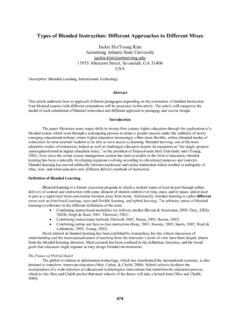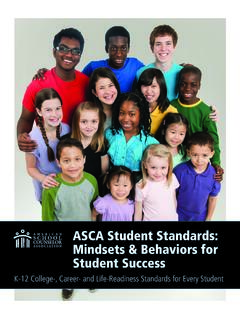Transcription of A Mixed Method Case Study of Student Engagement ...
1 A Mixed Method Case Study of Student Engagement , Technology Use and High School success Michele Jacobsen and Sharon Friesen, University of Calgary Jason Daniels and Stanley Varnhagen, University of Alberta Abstract: The relationship between technology use, Student Engagement and high school success was examined over two years. Surveys, interviews and classroom observations with students , teachers and school leaders informed Study findings. Teachers are enthusiastic about technology, but design low level, low challenge recall assignments and tests. Student interest in learning with technology is high, but Engagement tends to be low. Instruction is dominated by information delivery using display technology. Teachers must create meaningful, challenging and authentic Student work that integrates technology.
2 Leaders must create a shared vision for learning with technology in high schools; Research data on learning with technology must influence decision-making and systemic change in the education system. Overview To learn well in school, and to thrive and lead in a participatory and digital world, high school students need to be intellectually engaged in meaningful, challenging and complex work - work that is discipline rich, academically rigorous and motivates them to give over their hearts and minds to it. Intellectually engaging work motivates learners to challenge existing ideas, to build upon their passions and interests, and to develop explanations, arguments and solutions to problems that are complex enough to require collaborative teams of learners to investigate.
3 It is important to move high school learning beyond the broadcast approaches that may (or may not) have served us well in the past 50 years. Today's high school learners deserved to be engaged in participatory and technology enabled learning experiences and intellectually demanding inquiry projects in school (Bransford, Cocking & Brown, 2000; Jacobsen and Friesen, 2011; Jenkins, Clinton, Purushotma, Robinson &. Weigel, 2006). High school learners deserve to be well prepared for the ever-changing and digitally complex social, economic, political and cultural societies that they will inherit. The competencies and habits of mind that high school learners require to live and learn well in our media rich and socially connected global world differ from those even 10 years ago.
4 As our participatory digital world keeps changing, school jurisdictions and high schools cannot afford to stand still. While research has demonstrated that knowledge building is a key requirement for learners in the 21st century (Bransford, Cocking & Brown, 2000; Jacobsen, 2010a; Sawyer, 2006, 2008; Scardamalia, 2005;. Scardamalia & Bereiter, 2003), most high school teaching is still characterized by information delivery and prepared messages for individuals to sit still and consume. High school students need to cultivate their ability to work collaboratively to improve ideas and share them publicly. School jurisdictions and high schools and need to deploy current participatory pedagogies based on current research in the learning sciences (Sawyer, 2006, 2008) and research on how people learn (Bransford, Cocking & Brown, 2000) to make collaborative knowledge building and intellectually engaged learning a reality for all learners and teachers.
5 In the midst of a constantly changing and connected world, many high schools still do not or will not or cannot provide pervasive access to the robust technological infrastructures and network designs needed to serve citizens of a participatory and digital age well. While a small number of high schools now welcome Student owned devices or provide 1-2-1 laptop access coupled with open, unfiltered networks for teaching and learning, most high schools struggle to maintain older computer labs and continue to dole out bookable timeslots; further, many school jurisdiction IT departments filter content and throttle the school networks, which limits further any innovative uses of technology. School jurisdictions need to put the proper technological resources in the hands of all learners and teachers.
6 All stakeholders in education, from the Educational Ministry, to Universities, to the Professional Associations, to the school jurisdictions and community leaders, need to invest in and support teachers in designing intellectually engaging work for students to do work that is worth their time and effort. The question that schools systems have to face is not whether this is the technology and media environment they want because this is the connected and digitally enhanced environment that we have global, social and pervasive. Instead, high schools need to be asking how to change the way that teachers design learning experiences 92. for students and how leaders and the profession can better support teachers and students in making best use of modern technological resources and open connectivity.
7 High schools need to become spaces in which learners with diverse strengths, interests, abilities and skills are brought together around collective interests to work collaboratively on shared goals and tasks, to create and share ideas, and to build and cultivate knowledge in a community. A challenge for high school is to reconcile impoverished technological infrastructures and locked down networks, and teacher-driven content delivery approaches with the collaborative knowledge building and participatory learning approaches and expectations of today's high school students . Clearly, transformative changes are needed to move high schools from rhetoric to the realities of visible learning and visible teaching (Hattie, 2009).
8 With technology in 21st century learning contexts. Technology and High School success Improving high school completion rates is a priority for the Government of Alberta and the provincial education ministry, Alberta Education. Recognizing that high school completion has both individual and societal benefits, Alberta Education works closely with school jurisdictions to explore and support innovative strategies to improve high school completion rates. It is well known that the effective use of technology can increase Student Engagement , impact Student achievement, increase Student and teacher ICT skills and, ultimately, change teaching practices. The Technology and High School success (THSS) initiative was part of Alberta Education's ongoing research into best practices in classroom technology implementation.
9 In 2007, a Call for Proposals was issued to all publicly funded school jurisdictions and charter schools in Alberta for research-supported proposals that would explore the use of technology to improve Student Engagement and success in high school. The emphasis for this grant funding was on initiatives that demonstrated innovative uses of technology-enhanced learning environments to improve Student learning and success in high school. In total, 24 school jurisdictions and/or charter schools were successful in receiving funding. A research team was funded to carry out the two-year, THSS research project in the 2008/2009 and 2009/2010 school years. The THSS initiative involved over 22,000 students and 420 teachers at over 70 schools in 24 school jurisdictions.
10 The majority of classes involved in this initiative were Grades 9 to 12. In this paper, the authors present a selective overview of key findings from the two-year investigation. The research findings presented in this paper emphasize intellectual Engagement , thoughtful and appropriate use of technology and the role of ongoing professional learning to support teacher development. Research Questions and Methodology The primary research question in the THSS Study was, What is the relationship between effective use of technologies, Student Engagement , and school success ? To answer this question, the research team explored a number of supporting questions: 1. What is the impact of technology on Student Engagement and success in school?







